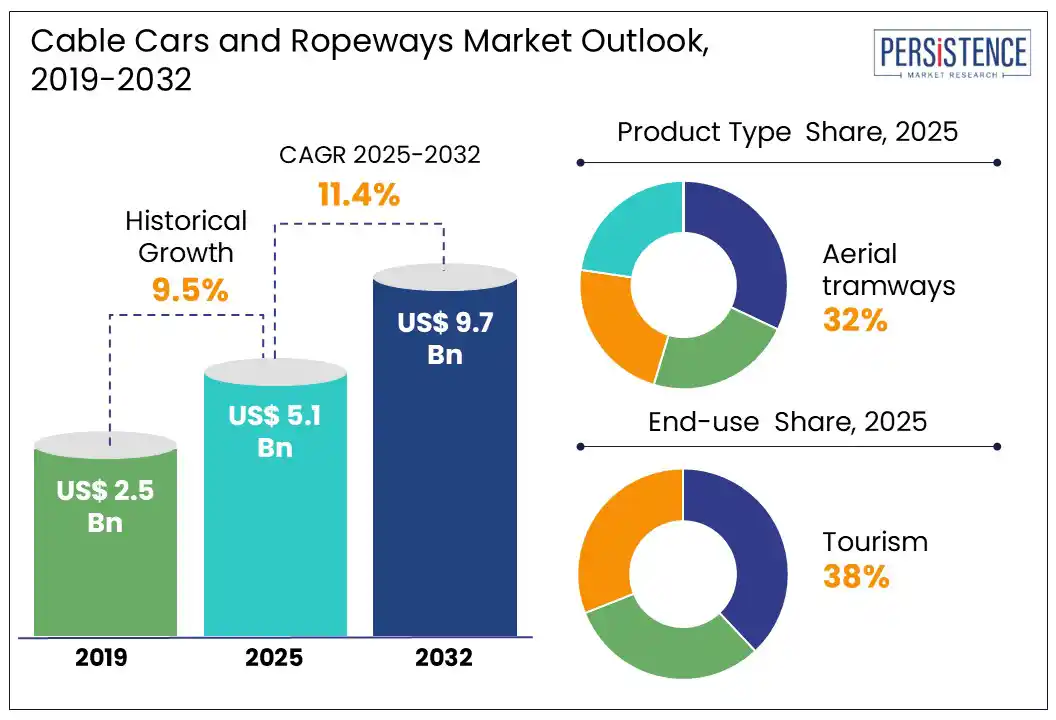ID: PMRREP11974| 198 Pages | 9 Jul 2025 | Format: PDF, Excel, PPT* | Automotive & Transportation

The global cable cars and ropeways market size is likely to be valued at US$ 5.1 Bn in 2025 to US$ 9.7 Bn by 2032, growing at a CAGR of 11.4% from 2025 to 2032. Cable cars and ropeways possess transport systems equipped with installed cables, with a third operational rope for propulsion. These are accompanied by one or two stationary ropes for support, which are commonly referred to as elevated streetcars.
The ever-growing travel and tourism sector is propelling the demand for cable cars and ropeways to entice visitors, facilitating market growth over the forecast period. The increasing global demand for tourism following the pandemic, coupled with technological developments in ropeway and zip-lining projects is further propelling the expansion of the cable car and ropeway market.
Aside from their appeal to the tourism sector, cable cars and ropeways also stand out for their environmental friendliness in both construction and operation. Their installation in mountainous regions or over water bodies is a more sustainable alternative to building bridges and roadways. This eco-friendly aspect, combined with their growing popularity in the tourism sector, is making cable cars a standard mode of transportation in mountainous regions.

Key Industry Highlights:
|
Global Market Attribute |
Key Insights |
|
Cable Cars and Ropeways Market Size (2025E) |
US$5.1 Bn |
|
Market Value Forecast (2032F) |
US$9.7 Bn |
|
Projected Growth (CAGR 2025 to 2032) |
11.4% |
|
Historical Market Growth (CAGR 2019 to 2024) |
9.5% |
Urbanization and growing concerns about pollution and traffic congestion have made cable cars and ropeways appealing for urban mobility. Such systems offer a practical alternative to conventional road-based transport in densely populated cities, especially those with difficult topographies.
Cities like Medellín, Colombia, and La Paz, Bolivia, have implemented cable cars as part of their public transportation networks, addressing congestion and accessibility in underserved urban areas. These systems reduce the need for extensive road networks, are energy-efficient, and have a smaller environmental footprint than buses and cars.
Governments are increasingly considering these systems as part of smart city initiatives to reduce urban sprawl, improve public transport, and lower carbon emissions. As cities prioritize greener transportation solutions, cable cars and ropeways are becoming preferred, offering high passenger throughput and low operating costs.
Another significant restraint for the Cable Cars and Ropeways market is the geographical and environmental limitations that restrict their applicability in remote areas. While these systems are ideal for mountainous or difficult-to-access regions, their deployment in flat or highly urbanized areas is often not feasible or necessary, limiting their overall market potential.
Weather conditions such as high winds, heavy snowfall, and storms can disrupt operations, posing safety risks and causing service delays. In coastal or tropical regions, harsh environmental factors like humidity and salt can lead to faster corrosion and wear on equipment, increasing maintenance costs and reducing system lifespan.
Regulatory challenges also arise in ecologically sensitive areas, where installing cable cars might face opposition due to environmental concerns such as habitat disruption or visual pollution. These geographical and ecological constraints limit the widespread adoption of cable cars and ropeways, confining their use to specific terrains and conditions.
The technological advancements in cable cars and the electrification of cable cars are driving opportunities for growth in the market. The rising awareness about environmental pollution is driving the adoption of electrical cable, though cable cars are more cost-effective, efficient, and environmentally friendly. Many cities are adopting cable cars for daily transportation, which is also driving the growth of the cable cars and ropeways market.
Additionally, the rising market competition, the entry of new market players in cable car manufacturing, and the ongoing research and development activities in the technological advancements in cable cars and ropeways are further contributing to the growth of the cable cars and ropeways market.
For instance, in April 2024, Faber Leisure Group launched futuristic SkyOrb cable cars. It is the world's first chrome-finished cabin with a spherical shape. It comes with mounted glasses on front, back and bottom to elevate the experience of cable car riding and tourism.
The product segmentation comprises aerial tramways, funicular ropeways, surface lifts and material ropeways based on product type. Among these, aerial tramways dominate the market. Aerial tramways facilitate connections between regions inaccessible by roads, so conveniently linking tourist destinations and mountain resorts.
Aerial tramways use wires, as wires traverse the surface and remain unaffected by soil conditions, rendering them appropriate for diverse topography. Aerial tramways possess larger passenger and cargo capacity than ropeway systems such as funiculars, enabling them to convey more passengers per journey and improving their economic feasibility. Its capacity to traverse extended distances on steep inclines enhances its attractiveness for transportation needs in challenging terrains.
Aerial tramways provide sweeping vistas throughout the journey, enriching the trip experience, making them a preferred choice for tourists, and contributing to their increased market share in the cable car and ropeways market.
By end-use, the segmentation includes divided into tourism, public transport and material handling. Among these, the tourism indsutry dominates the market. Cable cars and ropeways improve accessibility and provide access to picturesque sites for recreational and entertainment pursuits. The riding experience through mountainous and valley terrains enhances the inherent beauty of the landscape.
Numerous tourist attractions have established cable car links to renowned locations to enhance tourism, and superior passenger handling capacity satisfies the requirements of substantial tourist influxes.
The reliance of tourism sector on cable cars is further amplified by marketing campaigns that highlight distinctive travel experiences. Local authorities frequently utilize ropeway projects to enhance lesser-known tourism destinations. The tourism sector serves as the principal growth catalyst, sustaining its prominent status among end-users of cable car and ropeway technologies.

North America dominated the global cable cars and ropeways market owing to the heightened governmental expenditure in tourism infrastructure to entice visitors, and the proliferation of tourism activities propelling market expansion. This region is estimated to account for 35% market share in 2025.
The rapidly growing population and the heightened adoption of cable cars and ropeways as one of the important urban transportation methods are propelling the demand for the cable cars and ropeways market.
Many regional states are undergoing frigid temperatures and substantial snowfall, augmenting tourism activities and increasing the demand for cable cars and ropeways. Consequently, all these reasons propel the expansion of the cable cars and ropeways market.
Numerous cable cars and ropeways are operational in the United States, Algeria, Spain, China, and Brazil for urban transit. Urban areas have begun to recognize the potential of cable cars and ropeways as a solution to mobility requirements, enhancing the expansion of the cable car and ropeway market.
Asia Pacific is expected to witness the fastest growth during the forecast period. The market growth is attributed to the rising investment in the tourism industry and the rising demand for cable cars in the country like India which expanding its tourism industry and demand for the cable cars in religious places and mountain areas, and hill stations are driving the growth of the cable cars and ropeways market.
Cable cars are emerging as a modern mode of urban transport in several Asian countries, especially in regions with hilly or congested terrain. Ropeway systems are designed to offer ease of travel in hilly areas as an eco-friendly alternative to traditional transport. Projects in India, Vietnam, the Philippines, and China integrate cable cars into public transport networks, enhancing last-mile connectivity. These systems are particularly effective in tourist regions and dense urban areas where road expansion is limited. With growing urban populations and infrastructure investments, cable cars are becoming a practical, sustainable solution for intra-city mobility in Asia.
Europe holds a dominant position in the global cable cars and ropeways market, accounting for over 30% of the market share with more than 10,000 operational ropeway systems. Countries such as Switzerland, Austria, France, Germany, and Italy lead the region, with Switzerland alone operating over 1,700 installations and Austria more than 2,800. The market growth is driven by the region’s booming alpine tourism industry and the integration of cable cars into urban transportation to improve connectivity and reduce traffic congestion.
Rising demand for sustainable and energy-efficient transport solutions further fuels expansion. Investments in upgrading existing infrastructure and developing new projects in both tourist hotspots and urban centers are accelerating market growth. Europe’s focus on combining scenic tourism experiences with practical urban mobility solutions positions it as a key driver in the cable cars and ropeways industry, expected to grow steadily with a CAGR around 5.9% through 2030.
The presence of several key players, including Doppelmayr Garaventa Group, Leitner Group, POMA Group, and Bartholet Maschinenbau AG, characterizes the competitive landscape of the global cable cars and ropeways market. Leading companies dominate by offering advanced technology, extensive product portfolios, and comprehensive after-sales services. They serve commuters in regions with mountainous terrain having a high frequency of tourists across Europe, North America, and Asia Pacific.
The competitive environment is marked by innovation, with firms investing in automated and energy-efficient systems to stay ahead. Smaller regional players also compete by focusing on niche markets or specialized applications. Strategic partnerships, government contracts, expanding into urban transportation sectors are critical strategies for maintaining competitive advantage.
The global cable cars and ropeways market is likely to be valued at US$5.1 Bn in 2025.
Urbanization and infrastructure development & rising demand for sustainable transportation are the major growth drivers.
The cable cars and ropeways market is estimated to reach at a CAGR of 11.4% by 2032.
Urban transportation solutions and integration with smart city projects are the key market opportunities.
Bartholet Maschinenbau AG, CCM FINOTELLO SRL, Conveyor & Ropeway Services Pvt. Ltd., Damodar Ropeways & Infra Ltd., Doppelmayr Seilbahnen GmbH are a few leading players.
|
Report Attribute |
Details |
|
Historical Data/Actuals |
2019 - 2024 |
|
Forecast Period |
2025 - 2032 |
|
Market Analysis |
US$ Billion |
|
Geographical Coverage |
|
|
Segmental Coverage |
|
|
Competitive Analysis |
|
|
Report Highlights |
|
|
Customization and Pricing |
Available upon request |
By Product Type
By End-use
By Region
Delivery Timelines
For more information on this report and its delivery timelines please get in touch with our sales team.
About Author